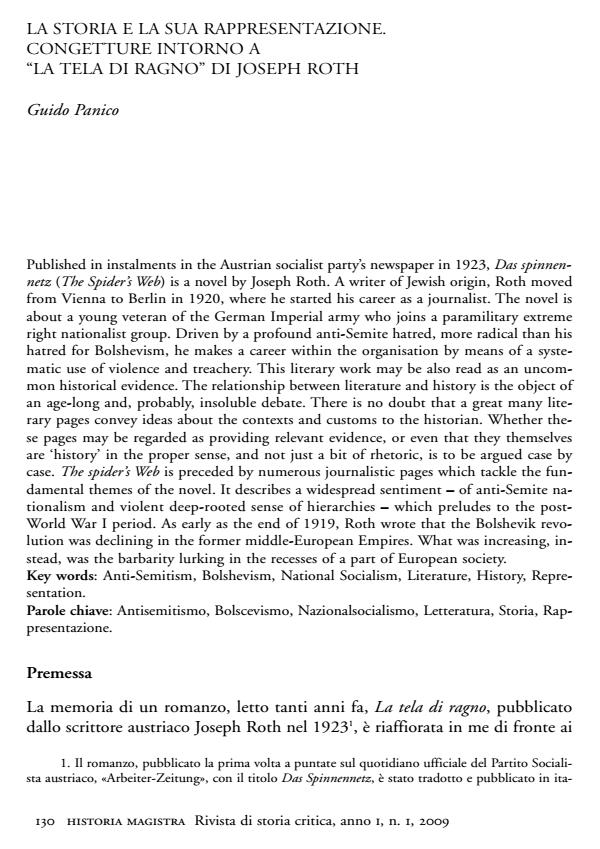La storia e la sua rappresentazione. Congetture intorno a "LA tela di ragno" di Joseph Roth
Titolo Rivista HISTORIA MAGISTRA
Autori/Curatori Guido Panico
Anno di pubblicazione 2009 Fascicolo 2009/1
Lingua Italiano Numero pagine 17 P. 130-146 Dimensione file 126 KB
DOI 10.3280/HM2009-001014
Il DOI è il codice a barre della proprietà intellettuale: per saperne di più
clicca qui
Qui sotto puoi vedere in anteprima la prima pagina di questo articolo.
Se questo articolo ti interessa, lo puoi acquistare (e scaricare in formato pdf) seguendo le facili indicazioni per acquistare il download credit. Acquista Download Credits per scaricare questo Articolo in formato PDF

FrancoAngeli è membro della Publishers International Linking Association, Inc (PILA)associazione indipendente e non profit per facilitare (attraverso i servizi tecnologici implementati da CrossRef.org) l’accesso degli studiosi ai contenuti digitali nelle pubblicazioni professionali e scientifiche
La storia e la sua rappresentazione. Congetture intorno a "LA tela di ragno" di Joseph Roth - Published in instalments in the Austrian socialist party’s newspaper in 1923, Das spinnennetz (The Spider’s Web) is a novel by Joseph Roth. A writer of Jewish origin, Roth moved from Vienna to Berlin in 1920, where he started his career as a journalist. The novel is about a young veteran of the German Imperial army who joins a paramilitary extreme right nationalist group. Driven by a profound anti-Semite hatred, more radical than his hatred for Bolshevism, he makes a career within the organisation by means of a systematic use of violence and treachery. This literary work may be also read as an uncommon historical evidence. The relationship between literature and history is the object of an age-long and, probably, insoluble debate. There is no doubt that a great many literary pages convey ideas about the contexts and customs to the historian. Whether these pages may be regarded as providing relevant evidence, or even that they themselves are ‘history’ in the proper sense, and not just a bit of rhetoric, is to be argued case by case. The spider’s Web is preceded by numerous journalistic pages which tackle the fundamental themes of the novel. It describes a widespread sentiment - of anti-Semite nationalism and violent deep-rooted sense of hierarchies - which preludes to the post- World War I period. As early as the end of 1919, Roth wrote that the Bolshevik revolution was declining in the former middle-European Empires. What was increasing, instead, was the barbarity lurking in the recesses of a part of European society. Key words: Anti-Semitism, Bolshevism, National Socialism, Literature, History, Representation. Parole chiave: Antisemitismo, Bolscevismo, Nazionalsocialismo, Letteratura, Storia, Rappresentazione.
Guido Panico, La storia e la sua rappresentazione. Congetture intorno a "LA tela di ragno" di Joseph Roth in "HISTORIA MAGISTRA" 1/2009, pp 130-146, DOI: 10.3280/HM2009-001014